Key takeaways:
- Understanding and adapting to different learning styles enhances participant engagement and improves knowledge retention in workshops.
- Utilizing various assessment methods, such as surveys and observations, allows trainers to tailor sessions to attendees’ learning preferences.
- Incorporating diverse instructional methods and visual aids fosters a more inclusive and effective learning environment.
- Sharing insights about learning styles with participants creates a collaborative atmosphere and encourages reflection on individual learning journeys.
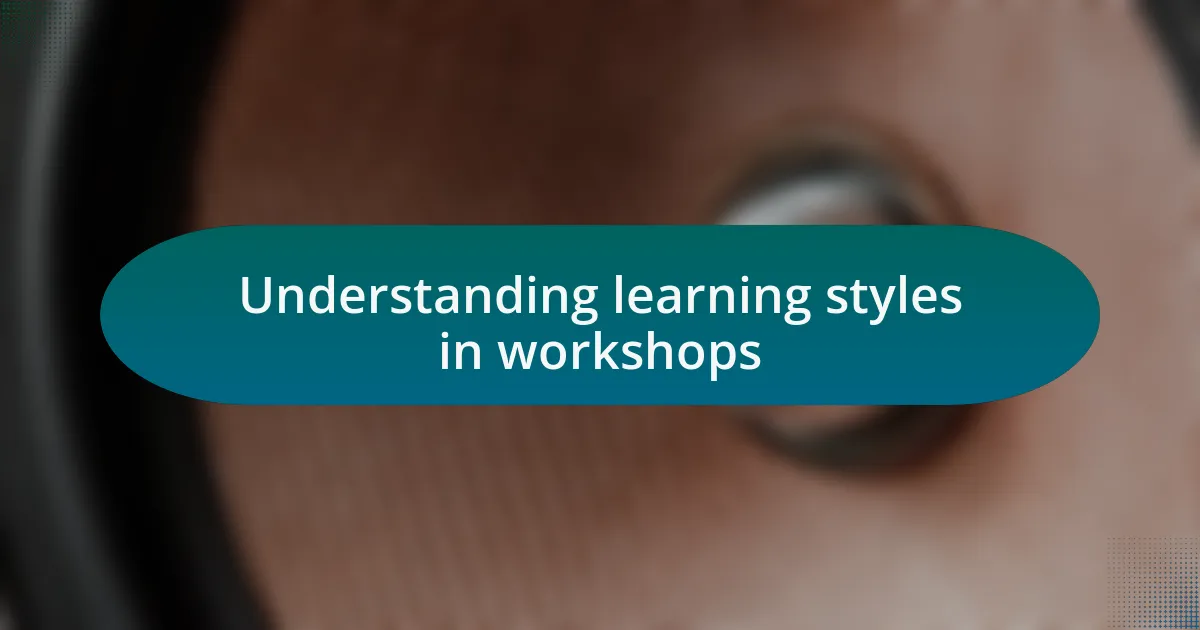
Understanding learning styles in workshops
Understanding learning styles in workshops is crucial for facilitating effective learning experiences. In my experience, I’ve noticed how some participants thrive on visual aids, while others feel more engaged through hands-on activities. Have you ever observed how a single graph can transform a complex concept into something relatable for visual learners?
I remember a tech workshop where I implemented various learning styles. I offered group discussions, hands-on coding exercises, and visual presentations. Participants with different learning preferences illuminated the room; it was fascinating to see how the energy shifted when everyone found their preferred method of learning.
Recognizing these styles also means being adaptable. When I see a participant struggling to connect with the material, I ask myself, “What can I do differently?” It’s a vital reflection that helps me tailor my approach. Understanding these nuances not only improves knowledge retention but also creates a more inclusive environment, ensuring everyone feels valued and engaged.
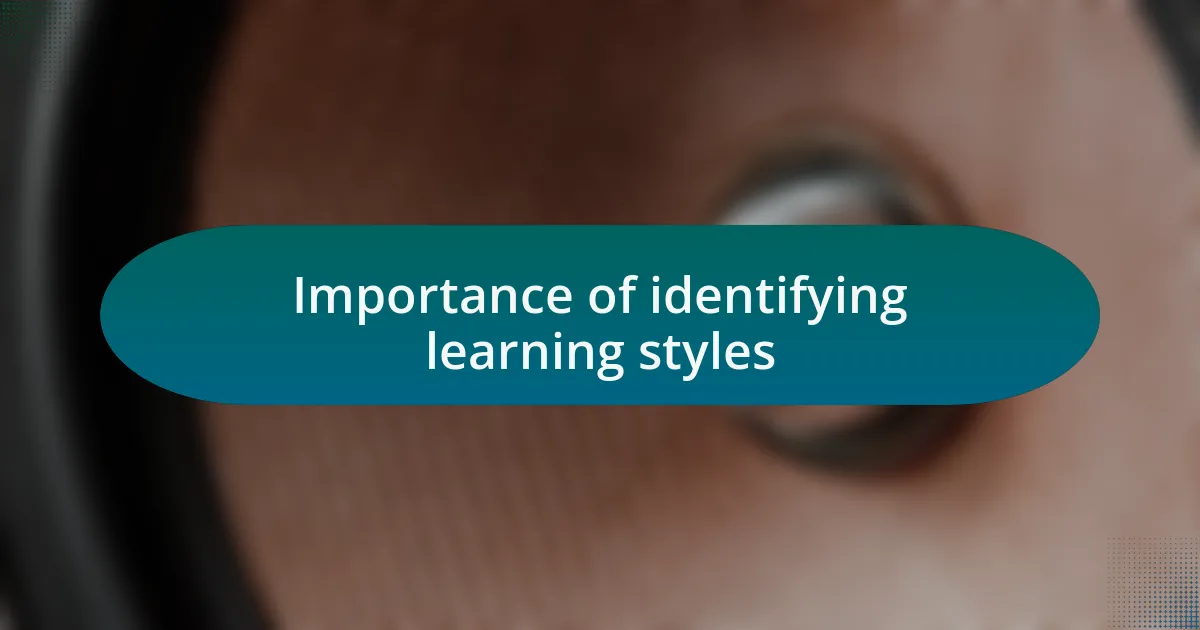
Importance of identifying learning styles
Recognizing learning styles is essential because it allows trainers to create more tailored workshops. I often think back to a time when I noticed a participant zoned out during a lecture-heavy session. By shifting to an interactive format, like a live coding challenge, suddenly the same individual sprang to life, contributing ideas. This emotional shift underlined why understanding how different people absorb information can transform the entire learning atmosphere.
Moreover, when I consider my own learning journey, I find that identifying my style has been the key to unlocking my potential. I vividly recall a workshop where the instructor used varied methods—some participants thrived on auditory explanations, while others flourished in visual storytelling. This diverse approach kept the momentum high and engagement levels soaring. Isn’t it intriguing how catering to individual learning preferences can elevate the experience for everyone involved?
Finally, embracing diverse learning styles fosters a sense of community and collaboration. When participants are encouraged to share their insights and preferences, it opens up rich dialogues. In one memorable session, I witnessed participants pair up across different backgrounds—an auditory learner teamed with a kinesthetic learner—and they sparked innovation in their project. Recognizing and embracing these styles isn’t just about the material; it’s about building connections that enhance the learning experience for all.
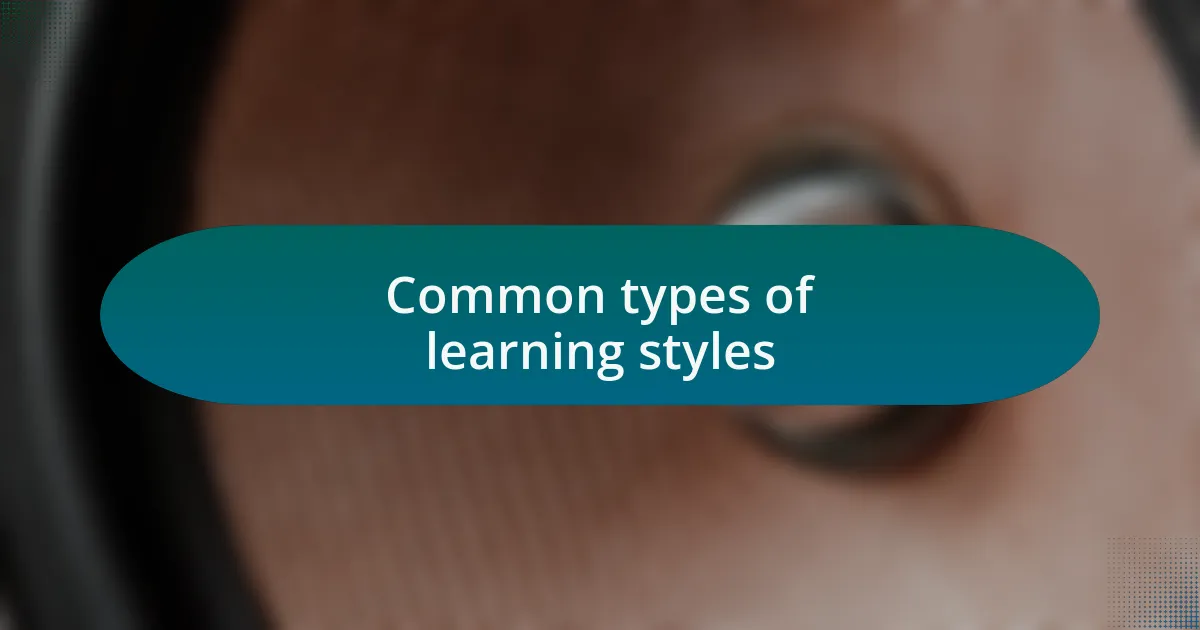
Common types of learning styles
There are several common learning styles that often emerge in workshop settings. For instance, visual learners typically grasp information best through images, diagrams, and charts. I remember leading a workshop where I incorporated vibrant infographics; the buzz of excitement was palpable as participants used those visuals to connect concepts. Isn’t it fascinating how a simple chart can ignite curiosity and foster deeper understanding?
Auditory learners, on the other hand, benefit from hearing information. I once had a participant who thrived during a group discussion format. As we shared ideas verbally, I noticed their eyes lighting up with each contribution. This experience reminded me how impactful sound can be—how does one’s learning journey change when they simply hear rather than just read?
Then we have kinesthetic learners, who need hands-on experiences to truly engage with the material. I recall a time when we hosted a tech workshop and had stations for participants to physically interact with tools. The energy in the room shifted, and participants were diving into experiments and activities with enthusiasm. Engaging those who learn best by doing can transform the mundane into the extraordinary—how can we harness this energy to make learning more impactful?
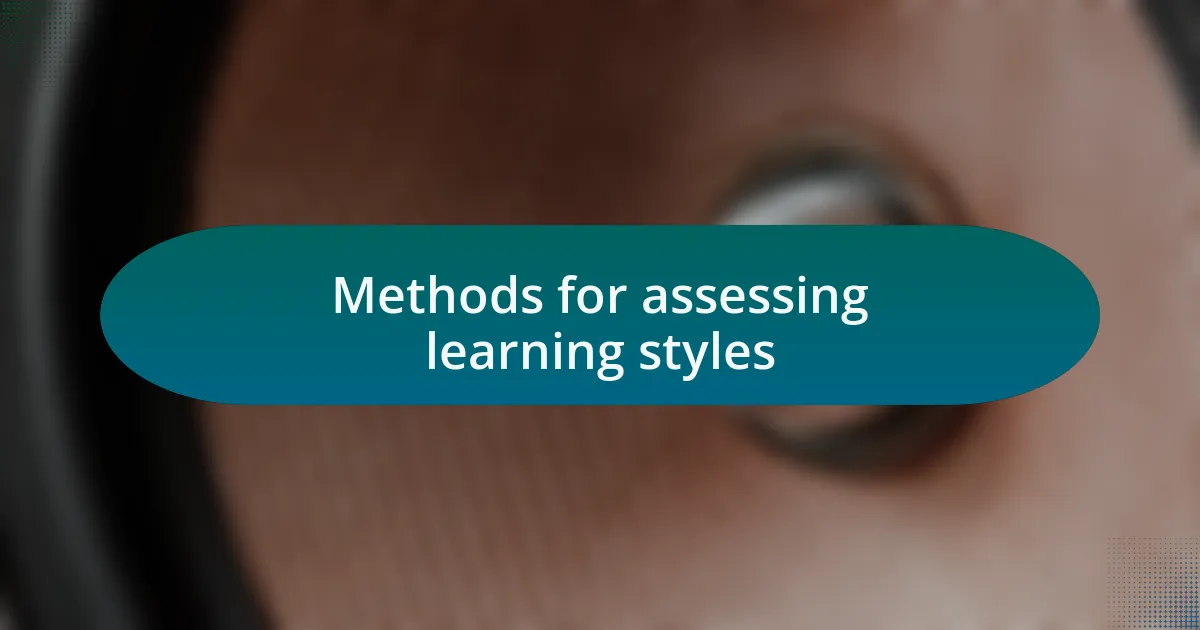
Methods for assessing learning styles
Assessing learning styles can be accomplished through various methods, each offering unique insights into how participants absorb information. One effective approach I’ve utilized is administering pre-workshop surveys that ask participants to identify their preferred learning styles. I remember the first time I employed this method; the responses sparked intriguing conversations and allowed me to tailor the workshop content specifically to the group’s needs. Have you ever thought about how a few questions could shape an entire learning experience?
Another technique I’ve found helpful is observing body language and engagement levels during different activities. For instance, during a particularly interactive session, I noticed some participants were animated during hands-on tasks, while others appeared more engaged during discussions. This observation allowed me to adjust the pace and focus of the workshop on-the-fly. Isn’t it incredible how attuning to subtle cues can provide a real-time assessment of learning preferences?
Finally, conducting informal check-ins throughout the workshop can illuminate participants’ learning styles as well. I often ask for feedback during breaks—simple questions like, “Which activity did you find most engaging?” This anecdotal evidence guides me in adapting subsequent sessions. Have you ever considered this ongoing assessment approach, where participant energy dictates the learning environment? It can transform not just the workshop, but also how learners feel about their educational journey.
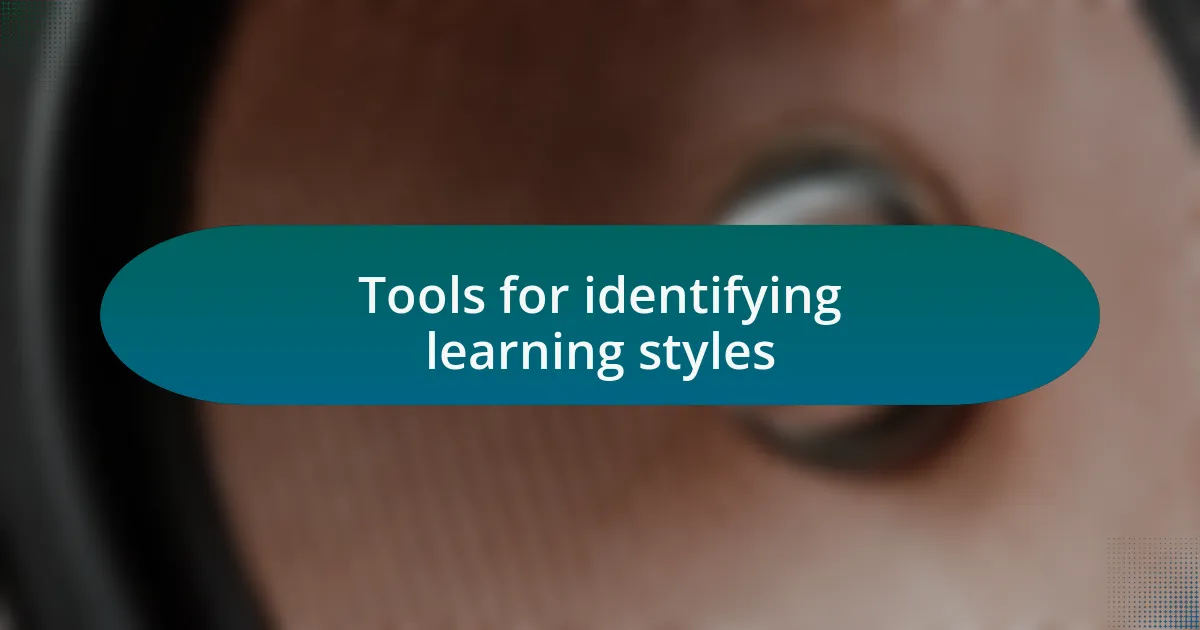
Tools for identifying learning styles
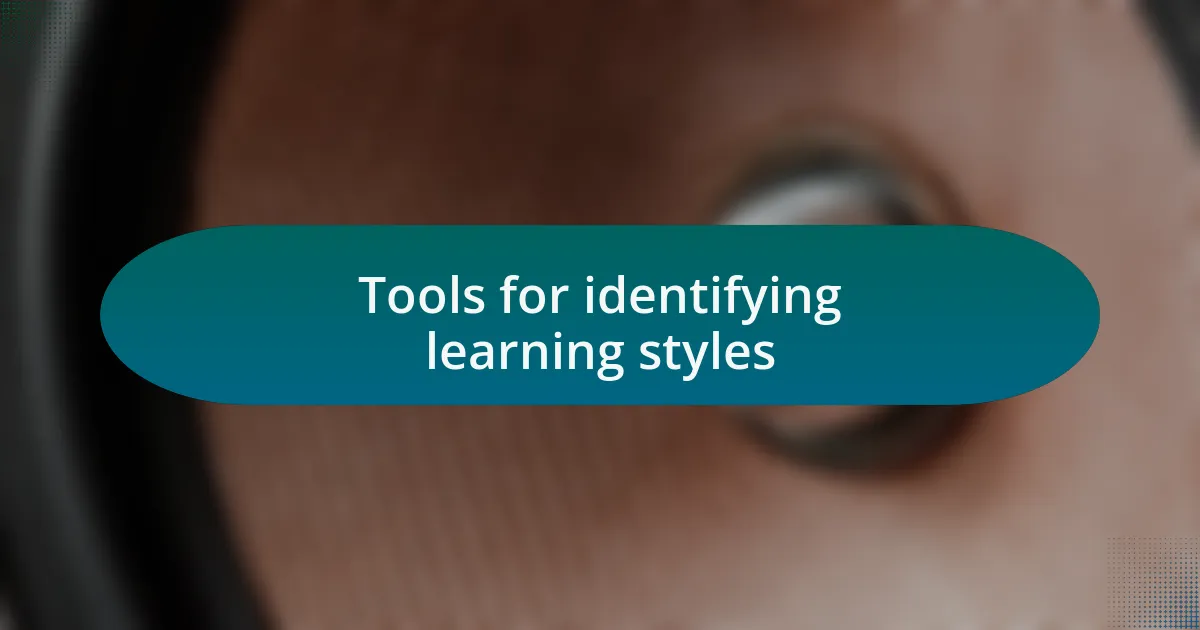
Tools for identifying learning styles
One tool I’ve found invaluable is the Learning Styles Inventory, a structured questionnaire. I used it in a recent workshop, and it provided a comprehensive snapshot of participants’ preferences. Everyone enjoyed learning about themselves, and the results allowed me to design a more effective agenda. Have you ever noticed how knowing your learning style can elevate your engagement?
Another effective method is using group discussions to explore varied perspectives. I remember a workshop where I encouraged participants to share their experiences with different learning styles. The energy in the room was palpable as they connected their thoughts and findings. This approach not only fostered camaraderie but also enhanced my understanding of different ways individuals process information.
Lastly, leveraging technology can be a game-changer. Tools like interactive learning platforms or mobile apps assess learning preferences through engaging exercises. I once used an app that gamified the assessment process, making it fun for participants while delivering valuable insights. Isn’t it fascinating how technology can bridge the gap between learning styles and our understanding of them?
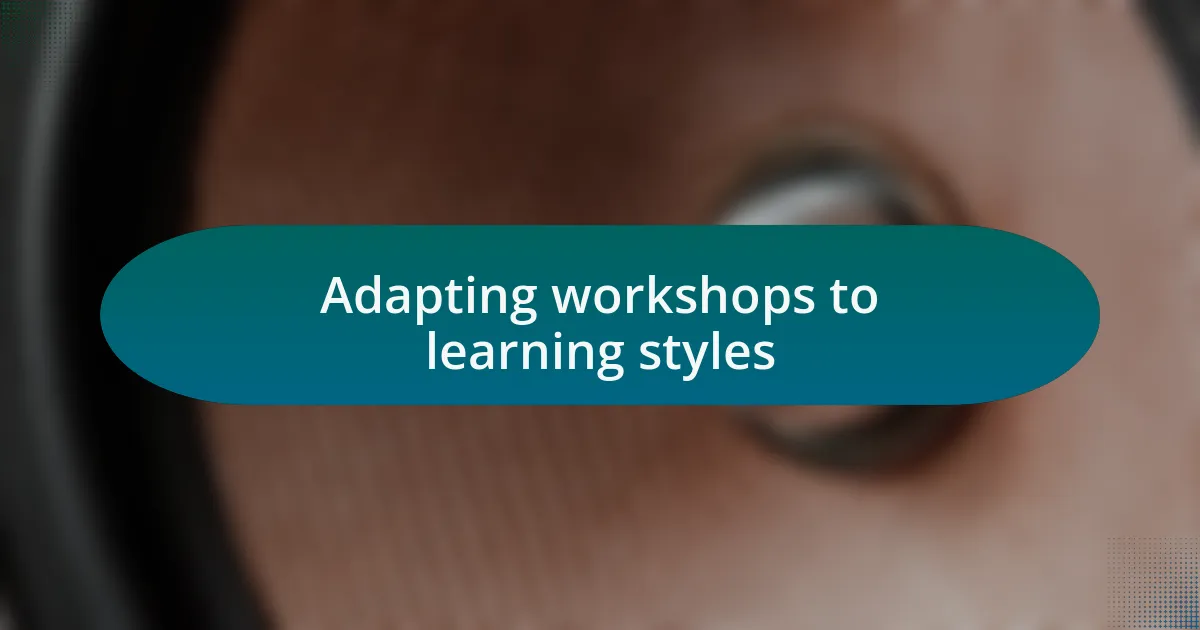
Adapting workshops to learning styles
When adapting workshops to cater to different learning styles, I’ve found that varied instructional methods must be integral to the design. For example, in one session, I included hands-on activities alongside traditional lectures. The moment I saw the kinetic learners lighting up during a group project, I realized just how essential it is to mix things up for different types of learners. Have you ever witnessed firsthand the difference it makes when you switch the pace?
Visual aids can significantly enhance understanding, and I’ve personally experienced their impact in workshops. Once, I created infographics summarizing key concepts, and participants responded with enthusiasm. Seeing their eyes light up as they connected visuals to information was a reminder of how effective visual content can be. Do you think that sometimes we underestimate the power of a simple diagram?
Finally, I’ve learned that flexibility is key. During a recent workshop, I noticed participants struggling to engage with a particular topic. I quickly pivoted my approach, incorporating more discussions and collaborative tasks. Watching their engagement shift in real time demonstrated how responsiveness to learning styles can transform the energy in the room. Isn’t it fascinating how a small adjustment can lead to a significant boost in interaction?
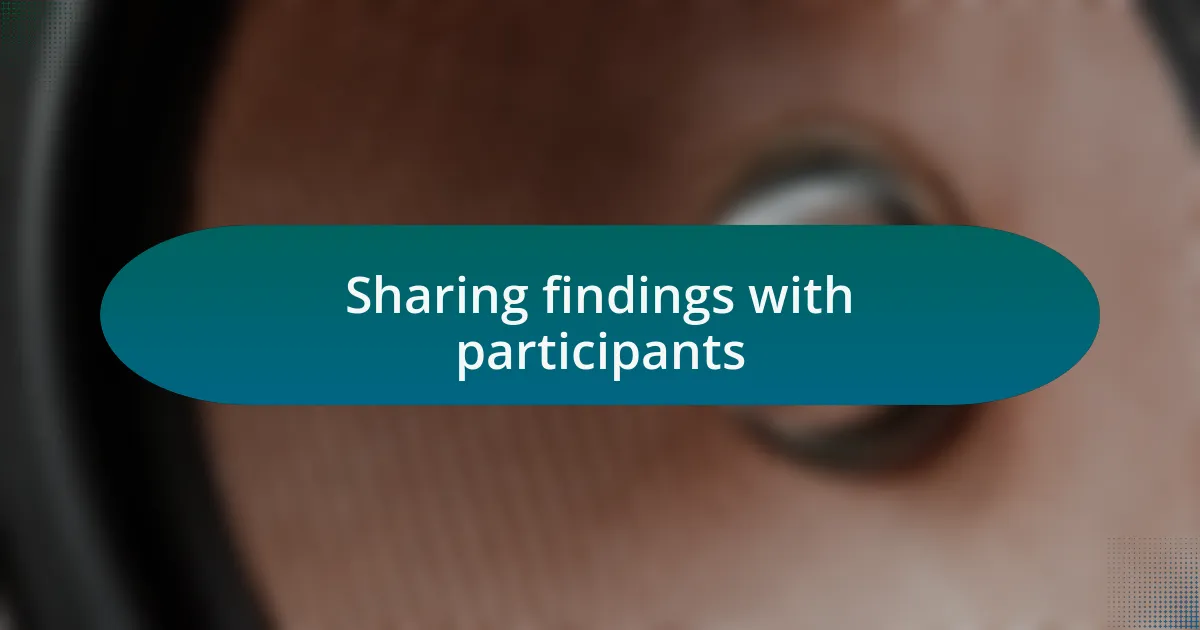
Sharing findings with participants
After the workshop, I always find it important to share the insights I gather about participants’ learning styles. During my last session, I took a few minutes to summarize the different styles identified, and the reaction was incredible. The participants appreciated the tailored feedback, and it sparked meaningful conversations about how they prefer to learn. Have you ever seen a group come alive when they realize their unique styles are acknowledged?
I remember one participant, a visual learner, eagerly approached me after the session. She expressed how empowering it was to see her learning preferences validated. I had taken the time to share specific strategies that catered to her style, and it made a lasting impact. Isn’t it remarkable how recognizing individual learning preferences can create such a connection?
Moreover, I find that sharing these findings often leads participants to reflect on their learning journeys. By discussing together how we can all leverage diverse styles, I create a shared language for future workshops. I think this collaborative spirit not only enriches the learning environment but also encourages participants to feel more engaged and invested. Have you thought about the collective wisdom that emerges when everyone shares their experiences?